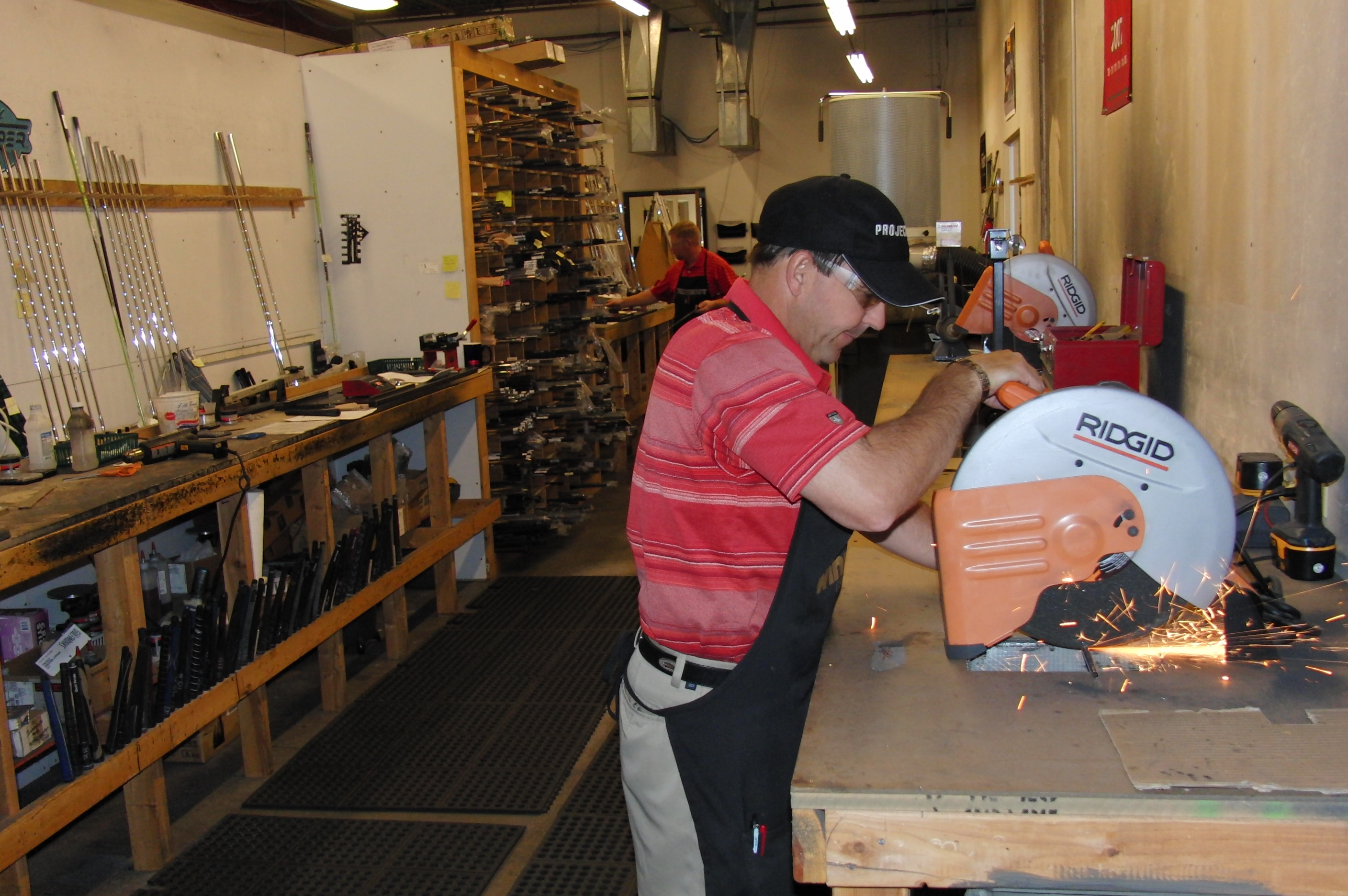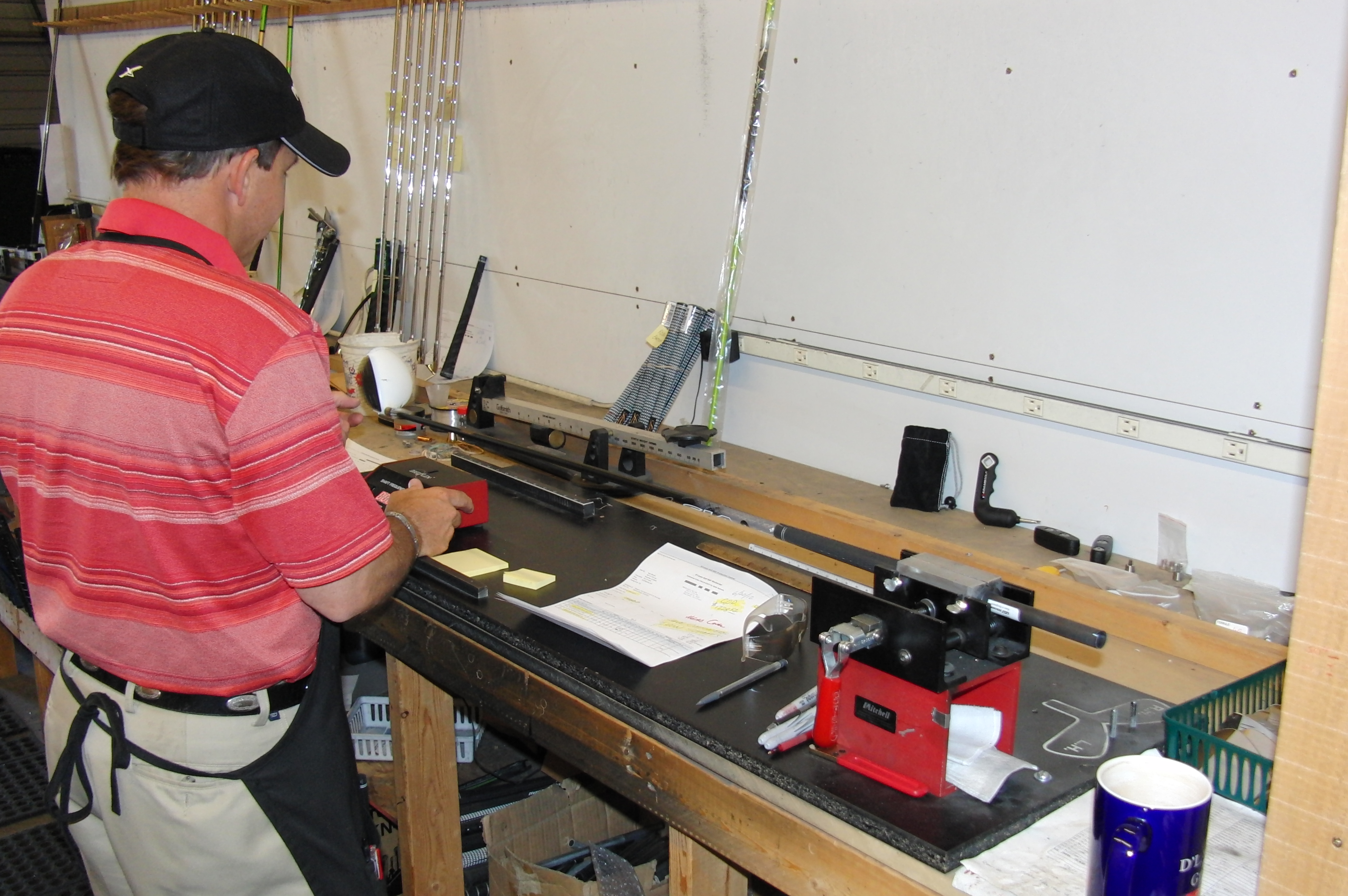I went from shooting in the low 100’s to the low 90’s with my new custom set of woods, hybrids and irons. Love the clubs! -Sarah S., Colorado Springs, CO (May, 2009)
What do you mean by custom built?
We build each club individually for our customers according to their specifications of length, flex, club head design, grip, loft, lie and weight. Prior to final assembly, we make sure that each club is individually tested for:
- Flex – butt stiffness (frequency matched)
- Spine alignment (FLO – flat line oscillation)
- Swing weight
Through each of the seven steps in the club building process, we follow strict quality control measures to make sure our clubs are of the highest quality craftsmanship.
Frequency Matching is the Key to Consistency
Each shaft, when set in motion on a frequency meter, has a unique dynamic vibrating frequency that is measured in cycles per minute or CPM. Clubmakers have found that to achieve consistency in the club performance from long irons through short irons, the frequency distribution must be uniform from club to club. This will make each club feel and perform alike. Now you will love all of your clubs, not just your 8-iron. We use the FM Precision scale to build our clubs as this scale gives the best results for beginner to professional. We can modify any club to within 1 CPM, or about a tenth of a flex.
Spine Alignment Creates More Accuracy
Each shaft, whether it is steel or graphite composition, has a certain degree of a “spine” or spot in the circumference of the shaft that is stiffer. If this “spine” is not aligned properly, the shaft will not return the club head squarely to the target line at impact resulting in inconsistent shot patterns. By testing each shaft prior to assembly, we know exactly where this spine occurs and can align the shaft properly during the building process. In our proprietary testing, we actually reject shafts that are outside of our specifications for Spine Index.
We also test to make sure this spine is aligned even after tip trimming to get to the proper butt stiffness using a method called FLO (Flat Line Oscillation) to make sure the shaft does not oscillate during the “dry fitting” step. This process guarantees that our customers will have clubs that perform consistently from club to club in their set. See our video on testing shafts for consistency and flex … here!
 We Re-engineer/Re-shaft all major brands
We Re-engineer/Re-shaft all major brands
If you have a set of clubs that you love to look at but just can’t hit them very well, or you purchased a new driver or rescue club and just can’t get it to perform, bring it to D’Lance Golf Performance Centers and we will put in the perfect shaft for you. We re-shaft every major brand of club including Callaway and Ping. Very few clubs cannot be reshafted.
At D’Lance Golf, we manufacture over 20,000 clubs each year. Over half of these clubs are re-shafts of existing clubs. We take the time necessary to produce quality custom clubs, individually tested and assembled. Our normal turnaround time is a week, however, in peak season (February thru August) it can take as long as three-weeks for a complete set. Individual clubs can be turned around in a couple of days, depending upon availability.
Our Q/A process ensures your success
We are very proud of our ability to custom fit and custom build clubs to your EXACT specifications. After each club is assembled, it is inspected for frequency, swing weight, length, loft, lie and total weight. The result is a perfectly matched set of clubs built exactly to your specifications.
Are all clubfitter’s the same?
Unfortunately not. There are several companies that have their own methods for fitting golfers. While they do an excellent job, we focus on not only fitting clubs but building them to your exact specifications. For example, we know that major manufacturer’s cannot possibly build all clubs individually. We do. Our club fitters have been professionally trained in our production facility by our Master Clubbuilders. We are serious about helping our customers play better golf.
The lie angle is the angle the shaft makes when the club is resting flat on the sole of the club. We talk about lie angles that are too flat (toe of the club is pointing down at impact), or too flat (toe of the club is pointing down at impact), or too
 upright (toe pointing up at impact). If your clubs are too flat you will tend to hit shots right of target (for right-handed golfers). If your clubs are too upright, you will tend to hit shots left of target. The effect of incorrect lie angles on direction is more pronounced with shorter clubs, like wedges than for a longer club. If your lie angle is off by 2 to 4 degrees, you will hit your wedge 5 to 10 yards off line from 120 yards!
upright (toe pointing up at impact). If your clubs are too flat you will tend to hit shots right of target (for right-handed golfers). If your clubs are too upright, you will tend to hit shots left of target. The effect of incorrect lie angles on direction is more pronounced with shorter clubs, like wedges than for a longer club. If your lie angle is off by 2 to 4 degrees, you will hit your wedge 5 to 10 yards off line from 120 yards!
When you are fitted for your clubs, we will determine the proper lie angle and then test the clubs again when you pick them up to make sure that every club is matched perfectly for you.
There is no such thing as a standard loft and lie. At D’Lance Golf everyone is measured for the perfect lie and then the club is adjusted using the Mitchell Lie and Loft machine. Lofts can also be adjusted based on the golfers needs and wants. Loft and
lie has such a significant impact on shot performance that even a 2-degree difference in lie can result in a 10 yard miss either left or right from an  average distance of 150 yards. Because everyone’s swing profile and flex is different, the lie and loft adjustment is crucial and must be looked at every year.
average distance of 150 yards. Because everyone’s swing profile and flex is different, the lie and loft adjustment is crucial and must be looked at every year.
THE D’LANCE DIFFERENCE
Without the proper equipment, practice and instruction can be futile. Using clubs that are not reacting properly to the way you swing will make what is already a difficult sport even harder. Improve faster and play better golf with equipment that fits. Don’t settle for off the rack clubs or custom fit equipment that doesn’t deliver custom built clubs. With custom fit and custom built clubs from D’Lance Golf you will play better golf and have more fun!
I had my career round with the new shafts – 78! Not bad for a 71 year old . -Art F., Aurora, CO (September, 2010)

